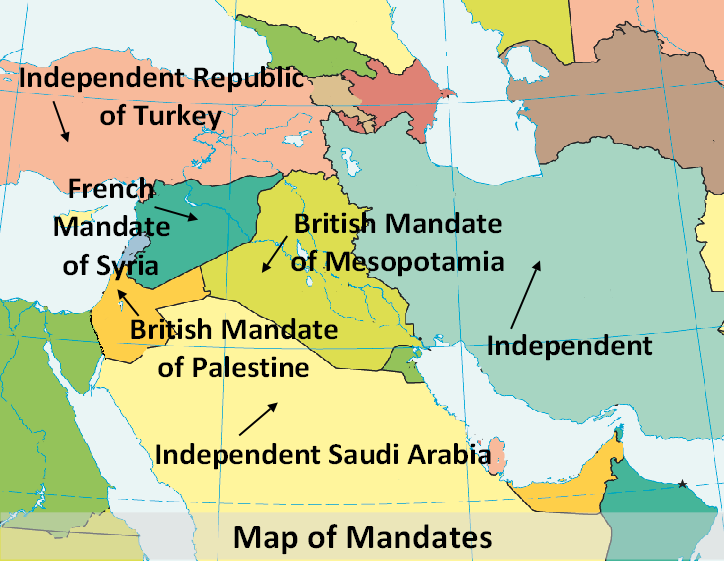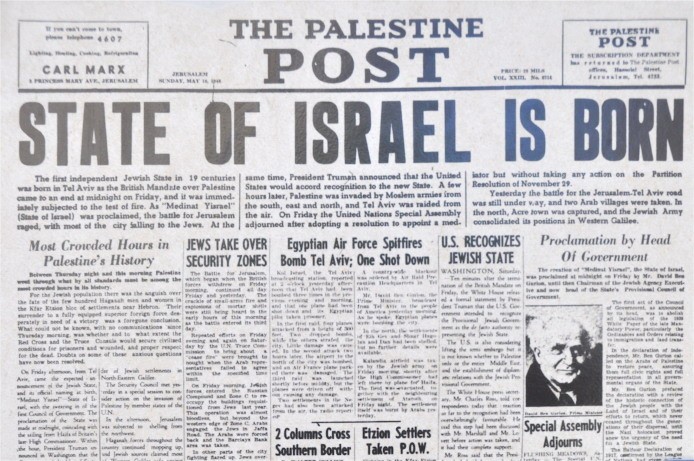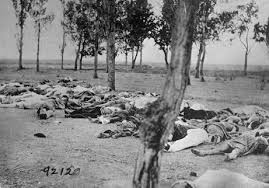On November 11, 1918, an armistice was reached on the Western Front – World War 1 was finally over. The burning question now was how the lands in the Middle East would be administered. Britain had made promises to the French and the Arabs to gain their support and had promised the Jews a homeland.
 The outcome was that the former Ottoman Empire was partitioned and the League of Nations (predecessor to the United Nations) mandated that Lebanon and Syria be overseen by France, and Palestine and Mesopotamia come under British administration. This arrangement lasted until the lands became self-sufficient enough to govern themselves. The Turkish War of Independence ended the Ottoman Empire and the Republic of Turkey emerged in 1923. The Kingdom of Iraq was formed in 1932, the Lebanese Republic became independent in 1943, and the Syrian Arab Republic and Hashemite Kingdom of Jordan followed both in 1946. Last of all was the State of Israel in 1948.
The outcome was that the former Ottoman Empire was partitioned and the League of Nations (predecessor to the United Nations) mandated that Lebanon and Syria be overseen by France, and Palestine and Mesopotamia come under British administration. This arrangement lasted until the lands became self-sufficient enough to govern themselves. The Turkish War of Independence ended the Ottoman Empire and the Republic of Turkey emerged in 1923. The Kingdom of Iraq was formed in 1932, the Lebanese Republic became independent in 1943, and the Syrian Arab Republic and Hashemite Kingdom of Jordan followed both in 1946. Last of all was the State of Israel in 1948.
The British Mandate – a Home for both Jews and Arabs
The San Remo Conference in April 1920 was called to allocate the League of Nations’ mandates, which were based on the Balfour Declaration of 1917. It was ratified by the League of Nations in July 1922.
 At this meeting, 77% of Palestine was given to the Arab Palestinians (the land east of the Jordan River). This area was re-named Transjordan in 1922 and later became the Hashemite Kingdom of Jordan in 1946. Thus the association of Jordan being the Palestinian homeland was erased from people’s memories. Transjordan comprised nearly 38,000 square miles of Palestine. Jews were not allowed to settle in this area.
At this meeting, 77% of Palestine was given to the Arab Palestinians (the land east of the Jordan River). This area was re-named Transjordan in 1922 and later became the Hashemite Kingdom of Jordan in 1946. Thus the association of Jordan being the Palestinian homeland was erased from people’s memories. Transjordan comprised nearly 38,000 square miles of Palestine. Jews were not allowed to settle in this area.
23% of Palestine was given to the Jewish people under this agreement. The area that became Israel was less than 8,000 square miles. However, Jews and Arabs were allowed to settle in this area west of the Jordan River. Within a few months, the British government’s White Paper of June 1922 restricted immigration quotas to the Jews, thus making it extremely difficult for Jews to enter but much easier for Arabs to live in this area, thus shifting the population balance further.
77% of Palestine was given to the Arab Palestinians for a homeland in 1923. It is now called Jordan.
Today, the historical fact that the Palestinians have already been given 77% of Palestine as their inheritance has been buried from common knowledge. If this were widely known, world’s assessment of the situation for the Palestinian people could be different.
When Israel became a nation in 1948, it offered citizenship to anyone who had lived within its borders for two years. Those who accepted are now Israeli Arab citizens with full rights. Some even serve in the Israeli government.
Palestine and the Palestinians
There is much ignorance about the terms Palestine and Palestinian which confuse and cloud the political issues today. The term ‘Palestine’ was first used by the Roman Emperor Hadrian when he finally subjugated the Jewish uprising in 132-135 AD known as the Bar Kochba revolt. Hadrian named the land ‘Syria Palestina’ after the ancient enemies of the Jews, the Philistines.
During the Ottoman period, the area that is today both Jordan and Israel was known as Palestine. The people who lived in the area of Palestine were called Palestinians, whether they were Arabs, Jews or Christians. ‘Palestinian’ is therefore not a race of people or even a tribe, but simply a term for those living in the area of Ottoman Palestine that became Jordan and Israel.
‘Palestinian’ is not a race or tribe, but a term for the inhabitants of Ottoman Palestine that became Jordan and Israel.
Even the Arabs were a collection of various tribal groups, not one group. Notably, Israel’s first newspaper (now The Jerusalem Post) was called the ‘Palestine Post’ and the Israel Philharmonic Orchestra was originally known as the Palestine Orchestra.
 The modern usage of the term ‘Palestinian’ is a political term used only since 1967 when Israel regained Jerusalem. Prior to that, the residents were called Jordanians.
The modern usage of the term ‘Palestinian’ is a political term used only since 1967 when Israel regained Jerusalem. Prior to that, the residents were called Jordanians.
In Islamic thinking, Allah is the supreme being and he cannot be dishonoured by losing land as this would mean another power was greater than Allah. This is to ‘lose face’ and brings shame in an honour-shame based society. Therefore, any usurper ‘occupying’ the land must be overthrown. Jihad must continue until this is accomplished and any peace agreement is only possible temporarily while the Muslims are in the weaker position, until they are strong enough to resume the fight. This explains a lot of what is currently happening.
The Armenian Genocide
Life under the Ottoman rule in 1914 was not easy, especially if you happened to be a Christian. Situated on Turkey’s eastern border is Armenia. Armenia was the first country in the world to officially declare itself Christian, in the early 4th century. By the 15th century it was completely absorbed into the Ottoman Empire. Any non-Muslims living under Muslim rule are called dhimmis. This status means they pay extra taxes, in order not to be killed, and are denied the rights of their Muslim superiors. They live in subjugation to Islamic law, called sharia law.
 On April 24, 1915, the day before the ANZACs arrived on the beach on the western side of Turkey, a massacre was beginning to unfold on the eastern border. Two hundred and fifty Armenian intellectuals were killed by the Ottomans, beginning a genocide that pales into insignificance the losses at Gallipoli. An estimated 1 to 1.5 million Armenian Christians were killed, sent on death marches through the burning desert with no food or water, deprived of houses and property, used as medical experiments, children gassed, women raped or sold as slaves, some crucified, drowned or burnt alive. A few escaped, some of whom came to Jerusalem and settled into what is now the Armenian quarter. A population of two million in the Ottoman Empire was reduced to 388,000 by 1922.
On April 24, 1915, the day before the ANZACs arrived on the beach on the western side of Turkey, a massacre was beginning to unfold on the eastern border. Two hundred and fifty Armenian intellectuals were killed by the Ottomans, beginning a genocide that pales into insignificance the losses at Gallipoli. An estimated 1 to 1.5 million Armenian Christians were killed, sent on death marches through the burning desert with no food or water, deprived of houses and property, used as medical experiments, children gassed, women raped or sold as slaves, some crucified, drowned or burnt alive. A few escaped, some of whom came to Jerusalem and settled into what is now the Armenian quarter. A population of two million in the Ottoman Empire was reduced to 388,000 by 1922.
Over a million Armenian Christians were murdered by the Ottoman Turks during World War 1.
There is no doubt that the residents whether Jews, Arabs or Christians living under this domination were pleased to be liberated.
Turkey is still in denial about this part of their history, and Australia’s official position is that it does not recognise these events as genocide. 1
Thankfully, under Mustafa Kemal, known as Atatürk, a new path was taken. As a young soldier, he probably contributed more to the defeat of the ANZACs at Gallipoli than anyone else, as he grabbed the high ground at Chunuk Bair ten minutes before the first ANZACs could reach it. He then led the 7th Turkish Army in Palestine. After the war, in 1923, he became modern Turkey’s first president, making many sweeping changes to secularise and westernise the nation. He made a remarkable gesture of reconciliation to his former foes, whom he obviously admired, which is one of the greatest speeches of all time, immortalised in stone at Gallipoli. In 1934, he wrote:

Those heroes that shed their blood and lost their lives ... You are now lying in the soil of a friendly country. Therefore rest in peace. There is no difference between the Johnnies [Allied soldiers] and the Mehmets [Turkish soldiers] to us where they lie side by side here in this country of ours...You, the mothers who sent their sons from faraway countries, wipe away your tears; your sons are now lying in our bosom and are in peace. After having lost their lives on this land they have become our sons as well.
Endnotes:
Pictures:
- Map of mandates – Base map - CIA World Fact Book https://www.cia.gov
- Map of Partition of Palestine – https://commons.wikimedia.org/wiki/File:PalestineAndTransjordan.png - Doron
- Newspaper – http://www.historama.com/online-resources/articles/israel/story_israel_first_independence_day_14_may_1948.html
- Armenian genocide – Armenian genocide https://en.wikipedia.org/wiki/Armenian_Genocide
- Atatürk’s statement, Gallipoli, Turkey – Jill Curry